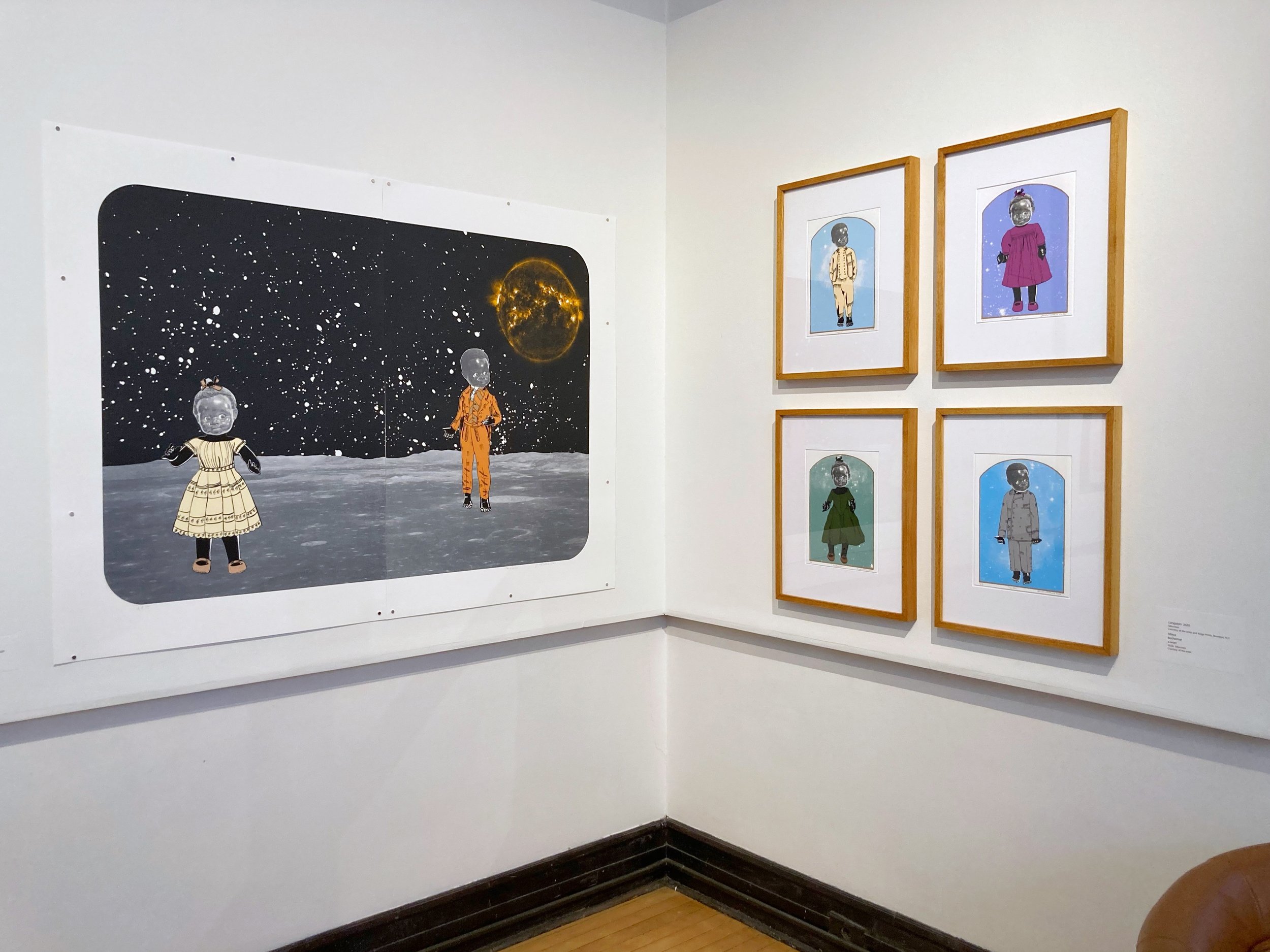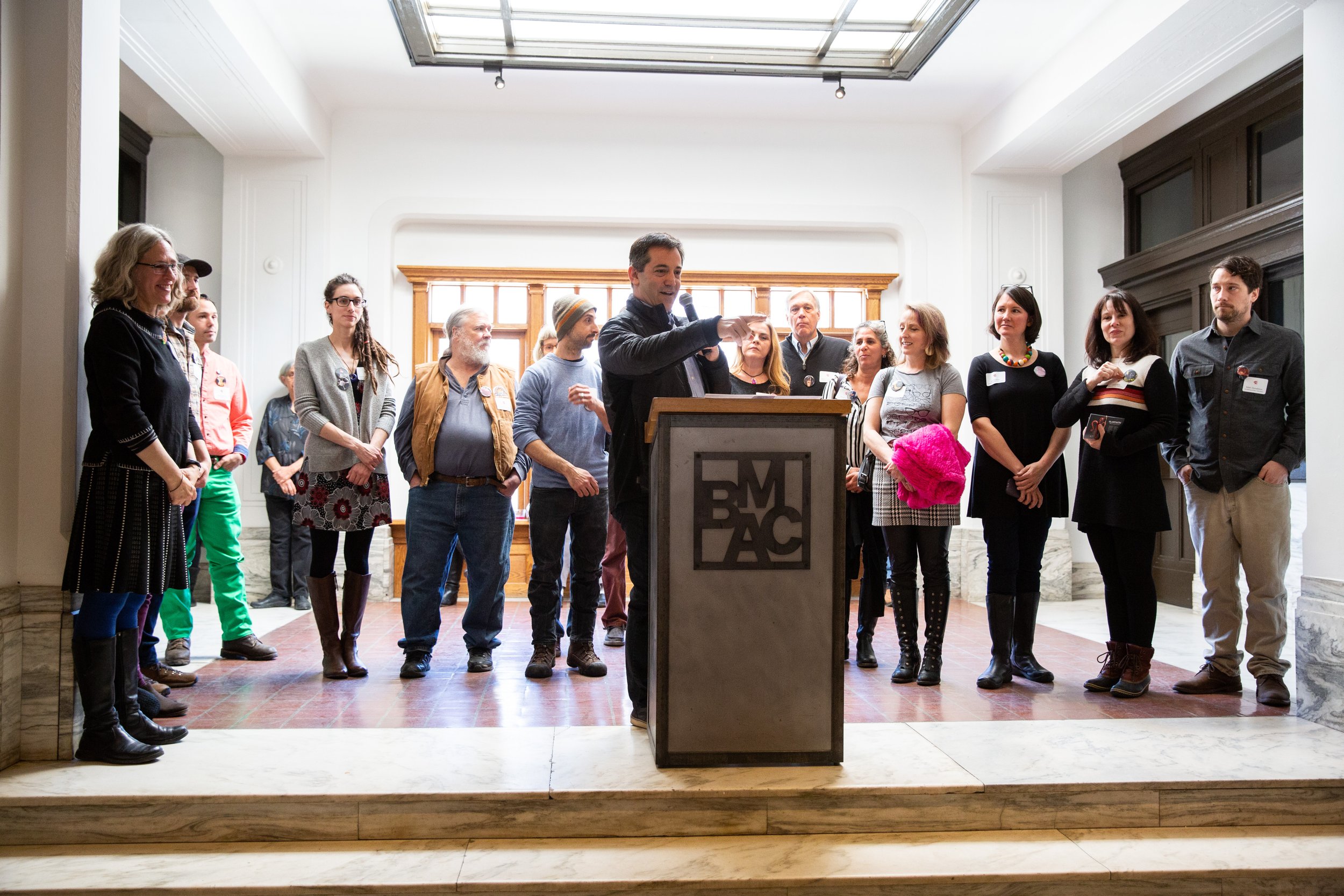“15 years doing a job I love”
On the 15th anniversary of his tenure as director of BMAC, Danny Lichtenfeld took some time to reflect on his non-traditional path to the job, the museum’s community-driven nature, the projects he’s especially proud of, and what he’s excited to work on next.
Danny holds master’s and bachelor’s degrees in Music Theory from the New England Conservatory of Music and a B.A. in American Studies from Tufts University. He joined BMAC as its director in September 2007.
BMAC: Before you came to BMAC, you worked in the music field. How did you end up at the helm of an art museum?
Picasso (middle) with Lichtenfeld’s great aunt and uncle, Paula Padani and Michael Aram
Danny Lichtenfeld: That’s a great question. It’s definitely not something I expected or would have predicted right up until the moment I was hired. I have always loved visual art, especially modern and contemporary art. My father’s uncle, Michael Aram, was an artist and friend of Picasso. My mother’s uncle, Sheldon Seidler, was also an artist and graphic designer who taught at The Cooper Union for many years. Their artwork was on the walls of my bedroom growing up. As a kid, I was always drawing and taking art classes, and in college, I became very interested in Minimalism and Land Art. However, when it seemed like I needed to choose one direction or another, I ended up focusing on music.
In college and graduate school, I studied the traditional music and dance of Ohkay Owingeh, a Native American community in northern New Mexico formerly known as San Juan Pueblo. That certainly made me an outlier at New England Conservatory, where the majority of students were pursuing careers in Western classical music. Fortunately, I had some very curious and open-minded teachers who supported my unusual path. And the work I found myself doing in New Mexico aligned nicely with my American Studies major at Tufts.
BMAC: What was it that appealed to you about that particular musical tradition?
Lichtenfeld: I couldn’t have told you this at the time, but in hindsight, I see that a big part of what I found so interesting and appealing about that music—and I think this is true of many Indigenous and folk music traditions—is that the it did not exist as “art” or “entertainment,” something you participate in as a departure from your daily life. On the contrary, the music was thoroughly entwined with the community’s social structure, agricultural systems, architecture, geography, and worldview. You couldn’t ask meaningful questions about the music without also considering all these other aspects of the life of the community. That felt very different than my experience at the time with Western classical music, which did not feel place-based or rooted in daily life.
I also appreciated the fact that, historically, in the musical/ceremonial tradition of Ohkay Owingeh, everyone in the community had a role to play. There wasn’t a notion of “virtuosos” or even of performers versus audience members, just participants.
Lichtenfeld and his teacher Peter Garcia (center) at Ohkay Owingeh in 1997 with students from Boston.
BMAC: Some might argue that art museums, historically anyway, do not exactly epitomize these ideas of non-hierarchical, community-focused, place-based art.
Lichtenfeld: And I would agree with them! Although I grew up in a family filled with artists and very encouraging of artistic pursuits, we didn’t spend a lot of time in art museums. I think we, like many people, thought of art museums as elitist, rarefied places, where people put on airs, and that just wasn’t our style. We felt more comfortable in science and history museums.
Because of that, when I learned about the job opening at BMAC, I had some doubts as to whether it would be a good fit. Those were quickly dispelled, however, when I met the very down-to-earth people working here and was interviewed by the Board. As I recall, the main thing they wanted to hear from me were my ideas about how to make BMAC even more welcoming to families, kids, and the many people in our community who, for whatever reason, had this preconceived notion that the museum was not a place for them. That was something I could relate to and was very excited to work on.
BMAC: Compared to other museums, do you consider BMAC to be unusual in its commitment to the community and its efforts to serve people who may not see themselves as museumgoers?
Lichtenfeld: I do, but perhaps not as unusual as it once was, because art museums are evolving—in wonderful ways. So many of them are doing truly inspiring work in collaboration with their communities, with historically marginalized groups, bringing art outside their walls, and removing barriers to access.
Historically, BMAC may have had a leg up in that approach, because, unlike many museums, we weren’t founded by a wealthy patron seeking to create a permanent home for their art collection. Deep down, that’s not who we are. BMAC emerged from the idealism and community spirit of a group of Brattleboro art and history enthusiasts who didn’t want to see Union Station turned into a parking lot. It’s been a community-driven effort right from the start.
Lichtenfeld and Mara Williams
As my predecessor Mara Williams often says, BMAC is not so much a traditional contemporary art museum as “a community-based aesthetic arena.” And if we weren’t—if we didn’t have such strong community buy-in—we wouldn’t be viable in a town as small as Brattleboro.
Here’s an example: When I was first hired at BMAC, an article about me ran in the Brattleboro Reformer. A day or two later, I was sitting at the bar at McNeill’s with a friend, and a guy sitting nearby came over and said, “Are you the new museum director?” I said yes, and he said, “Well, I want to tell you what I think you should do with the flooring in the main gallery, because it doesn’t work for exhibiting sculpture.” That was a real eye opener for me, in terms of understanding how much this place matters to the people here, how personally invested they are in their museum. If that weren’t the case, BMAC wouldn’t be here celebrating its 50th birthday.
BMAC: Speaking of which, as the museum approaches its 50th and you your 15th anniversary as director, what is on your mind?
Lichtenfeld: I know this will sound impossibly corny, but the answer is gratitude. I don’t generally spend a lot of time looking backwards. I’m more inclined to keep looking ahead, get excited about new projects, new ideas—but anniversaries have a way of making you take stock of where you’ve been and how you got here. When I do that, I think of all the people who have played a part in building and sustaining this unlikely museum over the past 50 years. We’re talking about literally thousands of volunteers, members, donors, and trustees, not to mention several generations of incredibly dedicated and hard-working staff members.
I’ve also been thinking about the countless people who sustain the larger ecosystem in which BMAC has the good fortune to exist—the educators, civil servants, community organizers, nonprofit leaders, and other miracle workers who make Brattleboro—and Vermont in general—a truly special place to live, work, and play.
Working at BMAC has also given me a tremendous appreciation for artists. Artists often thank me and the museum for the support and opportunities we provide them, but we at the museum are the lucky ones! We get to experience on a daily basis the creativity, clarity, vulnerability, courage, beauty, whimsy, and profundity that artists bring to their work every day. What a privilege it is to live in a world where artists make their art and bravely share it with the rest of us!











BMAC: Speaking of art and artists, when you look back over 15 years, are there any particular exhibits or projects that you’re especially proud of?
Lichtenfeld: I think we’ve done something like 200 exhibits while I’ve been here, and I’ve loved so many of them! That said, I am especially proud of the ones that have enabled artists to develop and show a new body of work—for example, Jennifer Mack-Watkins’ Children of the Sun, Roger Clark Miller’s Transmuting the Prosaic, or Mallory Lake’s Between Dark and Night, to name just a few.









I’m also very proud of the exhibits and programs we’ve developed in collaboration with community partners around important social issues—for example, If she has a pulse, she has a chance, which shone a light on people recovering from addiction, or Honoring Honar, a recent public art project featuring the work of five new residents of Brattleboro who are also members of the acclaimed Afghan artist collective, ArtLords. That project simultaneously introduced our community to some of its newest members and gave the artists an opportunity to reconnect with a part of themselves that was suppressed during the trauma of their forced emigration from their homeland.
I also have a special fondness for the enduring programs we’ve created to celebrate youthful creativity and non-traditional art forms, like our annual Domino Toppling Extravaganza, LEGO Contest & Exhibit, and Artful Ice Shanties. Oh, and I’m an absolute sucker for GLASSTASTIC!










BMAC: What’s next for you and BMAC? As you look ahead, what are you excited about?
Lichtenfeld: Where to begin? For starters, I’m incredibly excited about all the changes taking place outside the museum and along the riverfront. BMAC is situated right in the middle of it all, and I can’t wait to experience the transformation that’s finally getting underway in our corner of Brattleboro. And I’m looking forward to contributing to those efforts by expanding the museum and creating space for new programs and offerings that will allow BMAC to serve our community and region better than ever before.
I’m also thrilled about the work being done by BMAC’s new artistic and programmatic leaders: Director of Exhibitions Sarah Freeman and Manager of Education & Community Engagement Kirsten Martsi. We’re only just beginning to reap the rewards of their ideas, passions, and creative energy. I can’t wait to see where they will take us from here—and to bask in their reflected glow!
BMAC: Is there anything else you’d like to add?
Lichtenfeld: Just a great big thank you to everyone who has made it possible for me to spend the past 15 years doing this job that I love!








